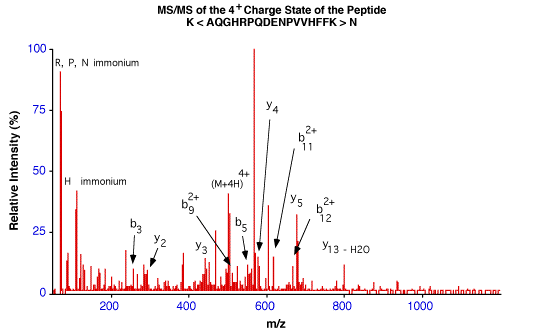MS/MS Interpretation
Fig. 2


Example of an evaluation of an MS/MS spectrum (parent ion m/z of 503.0) within the context of the known MBP and trypsin protein sequences and without predetermining the parent ion's charge-state. The first column, "CORR", is the cross-correlation score normalized to 1.00. The second column, "%", is the fraction of the total ion intensity which can be accounted for (excluding the intensities of the parent ion and its sequence-independent derivatives e.g. the parent minus H2O or NH3. "TERMINI" is the number of the peptide's termini that match consensus cleavage sites (0, 1, or 2). The output is sorted first by charge state and then by cross-correlation score. In this example, the highest scoring peptide was correctly identified despite the high parent charge, the wide error tolerance used to find possible parent peptides, and the the peptide's problematic composition which yields prominant multiply-charged internal fragments .
Post-translational Modification Interpretation
Fig. 3

b)
a) A section of a contour plot from an LC/MS of a tryptic digest of bovine fetuin. The ovals highlight four staircase-like patterns, each displaying the microheterogeneity of O-linked glycosylation on a single peptide (residues 246 to 306) in a single charge state. Each staircase represents a different charge-state of the same peptide.
b) Sherpa output for a glycosylation search corresponding to the region of the LC/MS illustrated in Fig. 3a. The heaviest ion group of 8277.72 Da. was observed in 5 charge forms. (This peptide is the top step of each charge-state staircase in part a.) In each staircase in 3a, the three lower steps are successively lighter glycoforms lacking one or more glycosyl moieties, as shown in the program output, 3b. The bottom listing indicates the results of a search which identified 5 possible glycopeptides. To the left are the masses predicted by adding specified combinations of monosaccharides to specified peptides. The total mass of each combination must be within a specified tolerance of the mass of the lowest step of the staircase. "Frag#", by convention, indicates the order of the fragment from the N-terminus (partial digestion products are indicated by the symbol ".." separating two fragment numbers). Previous studies by others indicate that the highlighted choice is the most likely to be correct.
Poster Page 1
 Poster Page 2
Poster Page 2
 Poster Page 3
Poster Page 3
Sherpa Home Page
 Univ. of Washington
Univ. of Washington
 Last Updated April 12, 1996
Last Updated April 12, 1996
J. Alex Taylor (jataylor@hairyfatguy.com)






 Poster Page 2
Poster Page 2
 Poster Page 3
Poster Page 3
 Univ. of Washington
Univ. of Washington
 Last Updated April 12, 1996
Last Updated April 12, 1996